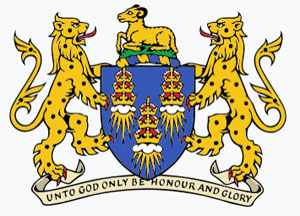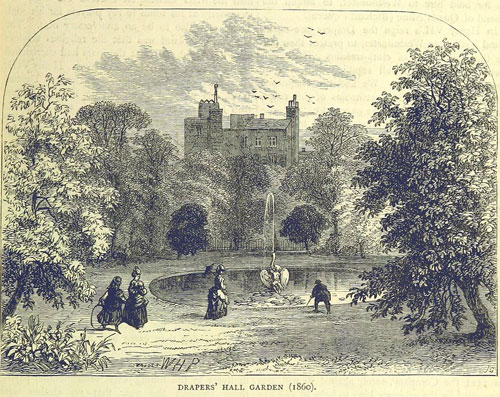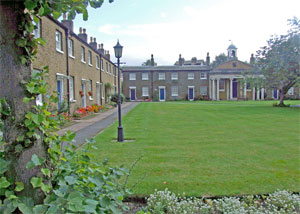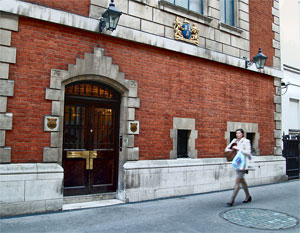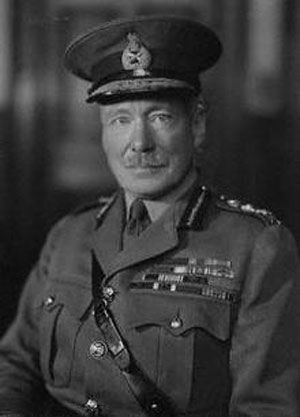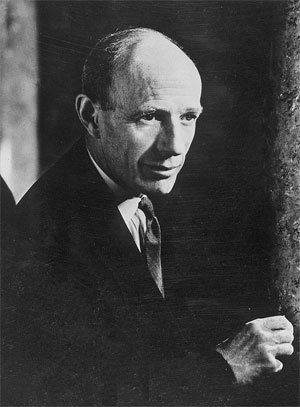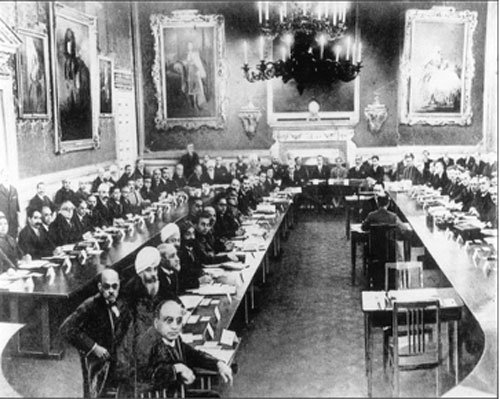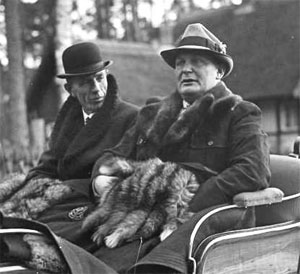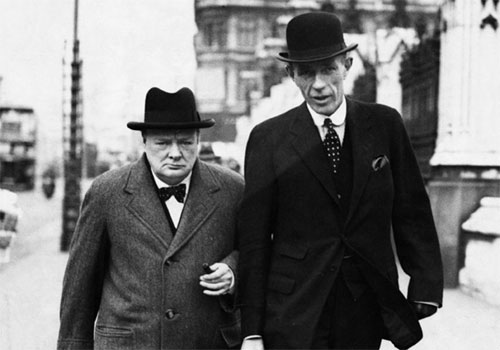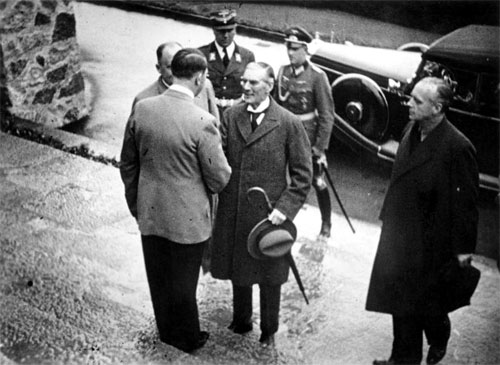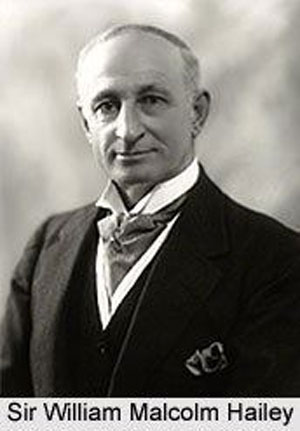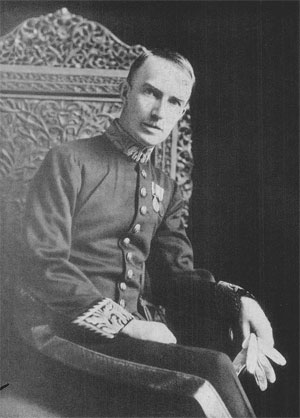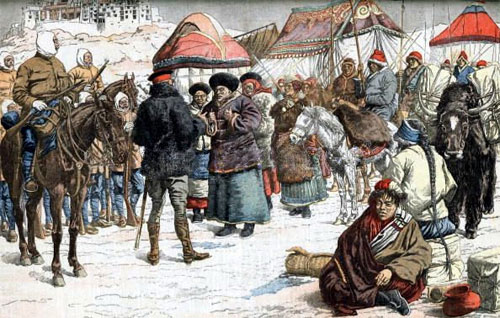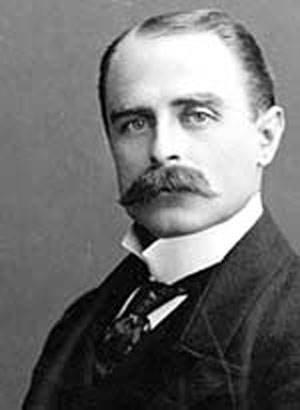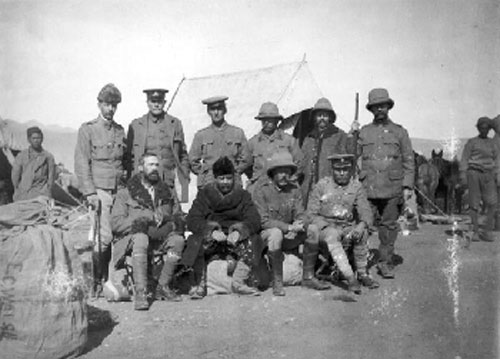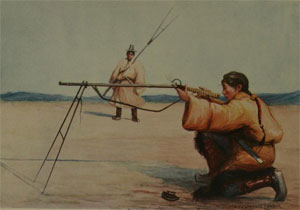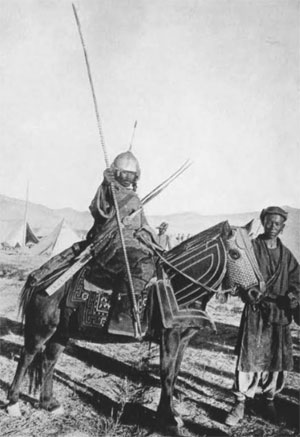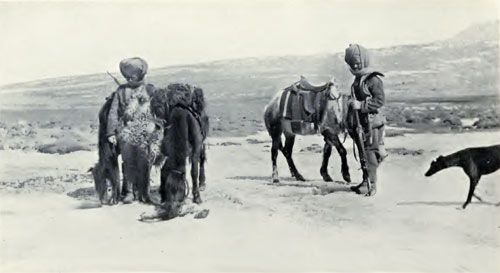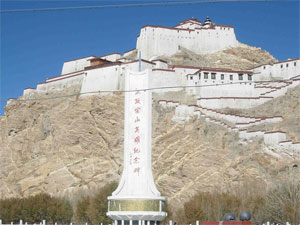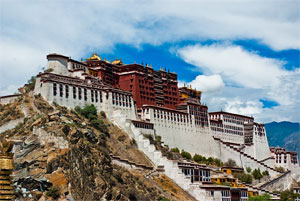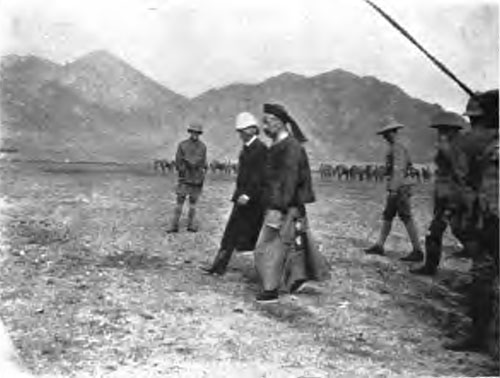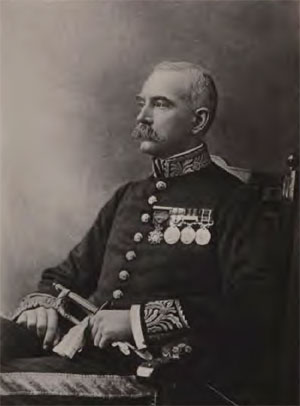Part 2 of 2
After MunichAfter Munich, Halifax (successfully) advised Chamberlain against capitalising on his popularity by calling a snap general election; instead he urged (in vain) that Chamberlain widen the National Coalition by offering jobs not just to Churchill and Eden but also to Labour and Liberal figures.[18] Halifax was also disgusted by the anti-Jewish pogrom of Kristallnacht (10 November). He advocated British financial aid to the countries of central and eastern Europe to discourage them from coming under Germany's influence.[18]
With Hitler's lack of commitment regarding the Munich Agreement becoming clearer, Halifax worked steadily to assemble a stronger British position, pushing Chamberlain to take economic steps to underpin British interests in Eastern Europe and prevent additional military supplies from reaching Germany, such as tungsten.
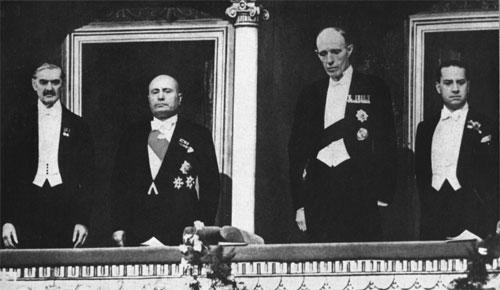 Neville Chamberlain, Benito Mussolini, Halifax, and Count Ciano at the Opera of Rome, January 1939
Neville Chamberlain, Benito Mussolini, Halifax, and Count Ciano at the Opera of Rome, January 1939In January 1939, Halifax accompanied Chamberlain to Rome for talks with Mussolini. That month Halifax pushed for staff talks with France, in view of the danger of war with both Germany and Italy simultaneously. After Hitler broke the Munich agreement and occupied the rump of "Czecho-slovakia" (the hyphen had been added after Munich), Chamberlain gave a speech in Birmingham on 17 March 1939, pledging that Britain would go to war to defend Poland. Halifax had been one of the drivers in this change of policy.[18] By March 1939, Eden, then out of office, observed that thanks to Halifax the government are "now doing what we would wish".[12]
Halifax granted a guarantee to Poland on 31 March 1939, triggered by alarming intelligence of German preparations, in hopes of sending clear signals to Germany that, in Halifax's words, there would be "no more Munichs".
The Foreign Office received intelligence in early April 1939 that Italy was about to invade Albania. At a Cabinet meeting on 5 April 1939, Halifax rejected these reports. Two days later, Italy invaded Albania; Halifax met Sir Alexander Cadogan and "decided we can't do anything to stop it".[20]
Although he disliked the Soviet regime, not least because of its atheism, Halifax was quicker than Chamberlain to realise that Britain should attempt to ally with the USSR. The negotiations (in summer 1939) failed, and the USSR allied with Germany instead on 23 August. It has been suggested that Halifax should have led the negotiations himself.[18] With Poland now looking likely to be carved up between Germany and the USSR (as indeed soon took place), the diarist "Chips" Channon, PPS to Halifax's junior minister Rab Butler, recorded (25 August 1939) that "the barometer of war kept shifting" and that "the Polish guarantee was [Halifax]'s pet scheme and favourite god-child" (Butler opposed the guarantee).[18]
When Germany invaded Poland, Halifax refused any negotiations while German troops remained on Polish soil. However, he stood solid with Chamberlain, who delayed in giving a commitment to go to war until the French also committed. The two of them were the objects of the Cabinet revolt which insisted that Britain honour the guarantee to Poland. Britain declared war on Germany on 3 September 1939.[18]
Phoney WarAfter the outbreak of war, Halifax's diplomacy aimed to dissuade the Soviets from formally joining the Axis. He opposed the bombing of Germany, lest the Germans retaliate.[18]
Swedish intermediary Birger Dahlerus had approached Britain for peace talks in August 1939, just before the outbreak of war. Again, on 1 November 1939, Halifax replied to an approach through Swedish channels that no peace was possible with Hitler in power. Even that aroused the wrath of Churchill, First Lord of the Admiralty, who sent a private note to Halifax rebuking him that such talk was dangerous.[21] Halifax remained opposed to any hint of a compromise peace during the Phoney War.[22]
In January 1940, Halifax met an emissary of Ulrich von Hassell, a leading member of the German resistance, who stated that "he personally would be against the Allies taking advantage of a revolution in Germany to attack the Siegfried Line."[citation needed]
Churchill as Prime MinisterOn 8 May 1940, Chamberlain's government survived a motion of no confidence brought about by the deteriorating military situation in Norway. The government had a nominal majority of 213 in the House: at the end of the "Norway Debate", they won the vote with a majority of only 81; 33 Conservatives and 8 of their allies voted with the opposition parties, and 60 abstained. Churchill had only grudgingly been appointed First Lord of the Admiralty. Nevertheless, he mounted a strong and passionate defence of Chamberlain and his government in the debate preceding the vote.[23]
Under ordinary circumstances, such a weak vote would not have been politically disastrous, but it was decisive at a time when the Prime Minister was being strongly criticised by both sides of the House and there was a strong desire for national unity.[24] Talking to Churchill after the vote, Chamberlain admitted his dismay and said that he would try for a coalition government with the Labour and Liberal Parties, but Churchill opposed that.
At 10.15 am the next morning (9 May), Chamberlain met with Halifax and Churchill in the Cabinet Room. Churchill's own account of these events, published eight years later in The Gathering Storm, the first volume of his The Second World War, does not tally exactly with contemporary accounts such as Halifax's own diary and Alexander Cadogan's record of his conversations with Halifax, or accounts given by Chamberlain or by the Chief Whip David Margesson (whose presence at the meeting Churchill does not mention). Churchill described a battle of wills in which Chamberlain opened the meeting by arguing that Churchill could not command the support of the Labour Party after he had had to defend the government at the Norway Debate, only to be met with a lengthy silence before Halifax, with some hesitation, expressed his own unfitness for the job. Other eyewitness accounts describe Halifax demurring much more rapidly, and Churchill actively agreeing with him. Churchill also misdates the events of 9 May to the following day, and although his writing assistant William Deakin accepted responsibility for this error he later confirmed, in an interview in 1989, that Churchill's account was embellished after numerous retellings and was not meant to be taken seriously.[25]
The description of Chamberlain attempting to persuade Churchill to agree tacitly to Halifax's appointment as Prime Minister is also hard to reconcile with Halifax's having expressed his reluctance to do so to Chamberlain at a meeting between the two men on the morning of the 9th.[26][27]
At 4.30 pm that afternoon Chamberlain held another meeting, attended by Halifax, Churchill, and the leader and the deputy leader of the opposition Labour Party (Clement Attlee and Arthur Greenwood respectively). He asked the Labour leaders if they would agree to serve in a coalition government. They replied that it might be possible but only with a different Prime Minister and that before they could give an official answer, they would need the approval of Labour's National Executive Committee, then in Bournemouth preparing for the annual conference which was to start on the Monday. They were asked to telephone with the result of the consultation by the following afternoon.[28][29]
In his diary entry for 9 May, written up the following morning, Halifax later wrote:
I had no doubt at all in my own mind that for me to succeed him would create a quite impossible situation. Apart altogether from Churchill's qualities as compared with my own at this particular juncture, what would in fact be my position? Churchill would be running Defence, and in this connexion one could not but remember the relationship between Asquith and Lloyd George had broken down in the first war... I should speedily become a more or less honorary Prime Minister, living in a kind of twilight just outside the things that really mattered.[30]
The Labour leaders telephoned at 5 pm on the 10th to report that the party would take part in a coalition government, although it had to be under the leadership of someone other than Chamberlain. Accordingly, Chamberlain went to Buckingham Palace to tender his resignation, recommending that the King ask Churchill to form a government.[28] On doing so, one of Churchill's first actions was to form a new, smaller War Cabinet by replacing six of the Conservative politicians with Greenwood and Attlee, retaining only Halifax and Chamberlain.
Churchill's political position was weak, although he was popular with the Labour and Liberal Parties for his stance against appeasement in the 1930s. He was unpopular in the Conservative Party, however, and he might not have been the choice of the King. Halifax had the support of most of the Conservative Party and of the King and was acceptable to the Labour Party. His position as a peer was a merely technical barrier given the scale of the crisis, and Churchill reportedly was willing to serve under Halifax. As Lord Beaverbrook said, "Chamberlain wanted Halifax. Labour wanted Halifax. Sinclair wanted Halifax. The Lords wanted Halifax. The King wanted Halifax. And Halifax wanted Halifax." Only the last sentence was incorrect, however; Halifax did not want to become Prime Minister. He believed that Churchill's energy and leadership skills were superior to his own.[31]
Unlike Simon, Hoare and Chamberlain, Halifax was not the object of Labour hatred in May 1940. Dutton argues that he "drew back" because of "inner self-doubt". "Political ambition had never been the most compelling motivation". He had a stomach ache, possibly psychosomatic, at the thought of becoming Prime Minister, and also probably thought that he could wield more influence as Churchill's deputy.[18] Like Chamberlain, he served in Churchill's cabinet but was frequently exasperated by Churchill's style of doing business. Like many others, Halifax had serious doubts about Churchill's judgement.[22]
May 1940 War Cabinet CrisisMain article: May 1940 War Cabinet Crisis
Germany invaded Belgium, the Netherlands, and France on 10 May 1940, the day that Churchill became Prime Minister. On 22–23 May, the German army reached the English Channel, isolating the British Expeditionary Force. Churchill soon had a confrontation with Halifax who believed that the United Kingdom should try to negotiate a peace settlement with Hitler, in view of the successful German invasion of France and the encirclement of British forces at Dunkirk, using Mussolini as an intermediary. He believed it better to try to get terms "safeguarding the independence of our Empire, and if possible that of France", in the belief that peace talks would make it easier to get the BEF home. He did not believe that there was any realistic chance of defeating Germany.[22] Churchill disagreed, believing that "nations which went down fighting rose again, but those which surrendered tamely were finished" and that Hitler was unlikely to honour any agreement. Moreover, he believed that this was the view of the British people.
On 24 May, Hitler issued the order for his armies to halt before they reached Dunkirk. Two days later, the British and French navies began an evacuation of the Allied forces, assisted by the Royal Air Force. Between 25 and 28 May, Churchill and Halifax each fought to bring the British War Cabinet around to their own respective points of view; by 28 May, it seemed as if Halifax had the upper hand and that Churchill might be forced from office. Halifax came close to resignation, which might have brought down Churchill's government.[22]
However, Churchill outmanoeuvred Halifax by calling a meeting of his 25-member Outer Cabinet, to whom he delivered a passionate speech, saying, "If this long island story of ours is to end at last, let it end only when each one of us lies choking in his own blood upon the ground",[32] convincing all who were present that Britain must fight on against Hitler whatever the cost. Churchill also obtained the backing of Neville Chamberlain, who was still Conservative Party leader.[22]
Churchill told the War Cabinet that there would be no negotiated peace. Halifax had lost. A few weeks later, in July 1940, Halifax rejected German peace offers presented through the Papal Nuncio in Berne and the Portuguese and Finnish prime ministers.
Halifax wrote in his memoirs of an occasion during a short holiday in Yorkshire:
One such interlude early in June 1940 is for ever graven into my memory. It was just after the fall of France, an event which at the time it happened seemed something unbelievable as to be almost surely unreal, and if not unreal then quite immeasurably catastrophic. Dorothy and I had spent a lovely summer evening walking over the Wolds, and on our way home sat in the sun for half an hour at a point looking across the plain of York. All the landscape of the nearer foreground was familiar—its sights, its sounds, its smells; hardly a field that did not call up some half-forgotten bit of association; the red-roofed village and nearby hamlets, gathered as it were for company round the old greystone church, where men and women like ourselves, now long dead and gone, had once knelt in worship and prayer. Here in Yorkshire was a true fragment of the undying England, like the White Cliffs of Dover, or any other part of our land that Englishmen have loved. Then the question came, is it possible that the Prussian jackboot will force its way into this countryside to tread and trample over it at will? The very thought seemed an insult and an outrage; much as if anyone were to be condemned to watch his mother, wife or daughter being raped.[33]
Ambassador to the United StatesWhen Chamberlain retired from the Cabinet due to ill health, Churchill tried to ease Halifax out of the Foreign Office by offering him a job as de facto Deputy Prime Minister, living at 11 Downing Street. Halifax refused, although he agreed to become Leader of the Lords once again.[22]
In December 1940, the Marquess of Lothian, British Ambassador to the United States, died suddenly. Halifax was told to take the job by Churchill, with the proviso that he could still attend meetings of the War Cabinet when he was home on leave in London.[22] Churchill's secretary John Colville recorded on 20 December that Churchill thought the Washington job was a great opportunity for Halifax to help bring the United States into the war. Colville recorded Churchill's view that Halifax "would never live down the reputation for appeasement which he and the F.O. had won themselves here. He had no future in this country." Colville thought Churchill had been influenced by the monthly censorship reports, which showed that Halifax had inherited some of Chamberlain's unpopularity.[34] Halifax was the last man linked with appeasement to leave the Cabinet, as Chamberlain had by then died, and both Hoare and Simon had already moved to other jobs. Halifax and his wife desperately tried to persuade Eden to take the Washington job instead, but to no avail. Eden was restored to the Foreign Office in Halifax's place, and Halifax set sail for the still neutral United States in January 1941.[22]
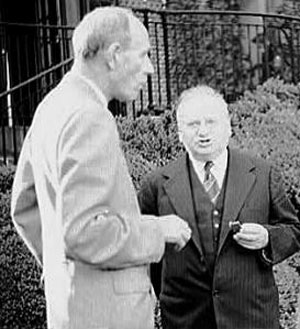 Halifax and Soviet ambassador Maxim Litvinov at a garden party in Washington, D.C. in 1942
Halifax and Soviet ambassador Maxim Litvinov at a garden party in Washington, D.C. in 1942President Franklin D. Roosevelt welcomed him in person when he arrived. Casting aside diplomatic protocols, Roosevelt took the presidential yacht the Potomac to greet Halifax as his ship made harbour in the Chesapeake Bay. Initially Halifax damaged himself by a series of public relations disasters. Two weeks after his arrival in the United States, Halifax went to Capitol Hill, meeting with House and Senate leaders. Upon leaving, Halifax told reporters that he had inquired about the timetable for passage of the Lend-Lease Act.[15] Isolationists seized upon the meetings to decry British meddling in American political affairs. He likened Washington politics to "a disorderly day's rabbit shooting".[22]
Halifax was initially a cautious and elusive public figure, not an effective public diplomat like his predecessor. His relations with Roosevelt were satisfactory, but Halifax kept a low profile. Churchill's close engagement with the United States and his investment in personal communication with the President meant a more constrained role for the British Ambassador. Communications technology meant that Churchill could communicate directly with Roosevelt and was a regular visitor to Washington.
Halifax's cousin Angus McDonnell helped him find his feet, and he soon led a very effective propaganda effort. Even an incident that autumn where he was pelted with rotten eggs and tomatoes by isolationists helped his reputation in the long run. He maintained good relations with Roosevelt and Harry Hopkins, and toured the country, meeting many more ordinary Americans than his predecessor had done. He became especially popular after Pearl Harbor.[22]
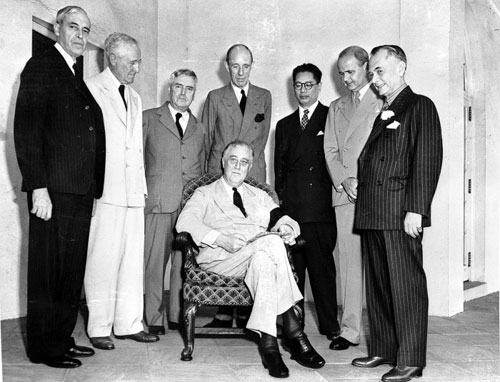 Lord Halifax in the middle (behind a seated Franklin D. Roosevelt) as a member of the Pacific War Council.
Lord Halifax in the middle (behind a seated Franklin D. Roosevelt) as a member of the Pacific War Council.Relations also increasingly turned on military issues channelled through the Joint Chiefs of Staff secretariat in Washington. Halifax wearied of Washington, especially after the death in action of his middle son Peter in November 1942, and the serious wounding of his younger son Richard in January 1943. In March 1943 he vainly asked Anthony Eden to be relieved of his post, but had to stay.[22]
In May 1944 he was created Earl of Halifax, the fourth creation of the title.[22]
Halifax took part in a plethora of international conferences over the UN and the Soviet Union.
With Labour in power under Clement Attlee from July 1945, Halifax agreed to Foreign Secretary Ernest Bevin's request to stay on until May 1946. In February 1946, he was present at Churchill's "Iron Curtain" speech at Fulton, Missouri, of which he did not entirely approve. He believed that Churchill's view of the Soviet threat was exaggerated and urged him to be more conciliatory. He also helped John Maynard Keynes negotiate the Anglo-American loan, which was finalised in July 1946.[12]
The final year of his Ambassadorship also witnessed the transition to President Harry S. Truman. Those years contained fraught moments and challenges for the relationship, as American power eclipsed that of Britain, and Britain's interests and rights were ignored on occasion, in particular, the cessation of nuclear co-operation after construction of the atom bomb. However, the partnership in World War II was immensely successful and as close as any other such partnership. It was a demanding post by any standards, but Halifax could reasonably claim to have played his part, and he enjoyed a notably longer term than his less successful successor Archibald Clark Kerr, 1st Baron Inverchapel.[original research?]
Later lifeBack in the United Kingdom, Halifax refused to rejoin the Conservative front bench, arguing that it would be inappropriate as he had been working for the Labour Government then still in office. The Labour Government were proposing that India become fully independent by May 1948 (later brought forward to August 1947) with no plans in place to protect minorities. Viscount Templewood (as Samuel Hoare was now known) opposed the plan, but Halifax spoke in the government's favour, arguing that it was not appropriate to oppose the plan if no alternative was suggested. He persuaded many wavering peers to support the government.[12]
In retirement he returned to largely honorary pursuits. He was Chancellor of the Order of the Garter. He was an active governor of Eton and Chancellor of Oxford University. He was an honorary Fellow of All Souls from 1934. He was Chancellor of the University of Sheffield and High Steward of Westminster. He was Master of the Middleton Hunt. He was President of the Pilgrims Society, a society dedicated to better Anglo-American relations. From 1947 he was chairman of the General Advisory Council of the BBC. From 1957 he was Grand Master of the Order of Saint Michael and Saint George.[12]
By the mid-1950s his health was failing.[12] One of his last major speeches in the House of Lords was in November 1956, when he criticised the government's Suez policy and the damage it was doing to Anglo-American relations.[12] He did little to challenge the critical view of appeasement which was then fashionable. His 1957 autobiography Fulness of Days was described in the Dictionary of National Biography as "gently evasive".[35] David Dutton describes it as "an extremely reticent book which added little to the historical record".[12] He gave the impression that he had been Chamberlain's faithful subordinate, omitting to mention his role in changing policy in spring 1939.[9]
He died of a heart attack at his estate at Garrowby on 23 December 1959, aged 78. His widow survived him until 1976.[12]
Halifax had sold Temple Newsam to the City of Leeds for less than market value in 1925, and in 1948 he donated 164 of his paintings to a museum being opened there by Leeds City Council.[36] His will was valued for probate at £338,800 10s 8d (not including settled land - land tied up in family trusts so that no individual has full control over it), equivalent to around £7m at 2016 prices.[37][38] Despite his great wealth, Halifax was notoriously mean with money. Rab Butler recounted a tale of how he had once been having a meeting with Halifax, his boss at the time. An official brought in two cups of tea and four biscuits for them; Halifax passed two of the biscuits back, instructing the official not to charge him for them.[37][39]
AssessmentsHalifax could not pronounce his "r"s. He had professional charm and the natural authority of an aristocrat, the latter aided by his immense height. He stood 1.96 metres (6 ft 5 in).[12]
Harold Begbie described Halifax as "the highest kind of Englishman now in politics" whose "life and doctrine were in complete harmony with a very lofty moral principle, but who has no harsh judgement for men who err and go astray."[40]
Harold Macmillan said that Halifax possessed a "sweet and Christian nature."[41]
Rab Butler called him "this strange and imposing figure—half unworldly saint, half cunning politician."[42]
In 1968, the official records were released of Halifax's years as Foreign Secretary (the "fifty-year rule" was replaced by the "thirty-year rule"). Conservative historian Maurice Cowling argued that Halifax's stance of increasing resistance to Hitler, especially the Polish guarantee in the spring of 1939, was motivated not so much by considerations of strategy but by a need to keep ahead of a sea-change in British domestic opinion. He wrote in 1975: "To history, until yesterday, Halifax was the arch-appeaser. This, it is now recognised, was a mistake. His role, however, was complicated. In these pages he is not the man who stopped the rot, but the embodiment of Conservative wisdom who decided that Hitler must be obstructed because Labour could not otherwise be resisted."[43]
David Dutton argues that Halifax, like Chamberlain, was slow to appreciate the sheer evil of Hitler and was overly confident that negotiation could yield results. His period as Foreign Secretary was "the pivot of his career and it remains the period upon which his historical reputation ultimately depends"; just as Eden saved his reputation by resigning in time, so Halifax damaged his by being Foreign Secretary in 1938–40. "He deserves some credit for abandoning, or at least for decisively modifying, the policy of appeasement". His refusal to seize the premiership in May 1940 was "the most significant act of his long career". He argues that later that month, far from being a potential Quisling, Halifax based his policies on rational considerations, and that "on rational grounds, there had been much to be said for the Foreign Secretary's line that Britain should at least have investigated what peace terms were on offer." However, his "most important role in public life" was, in Dutton's view, as Ambassador to the United States, where he helped to smooth a relationship which was "often more fraught than early interpretations … tended to suggest".[44]
Halifax College at the University of York is named after him. Lady Irwin College, a women's college in Delhi, was established under the patronage of Dorothy, Lady Irwin in 1931.[45]
Styles 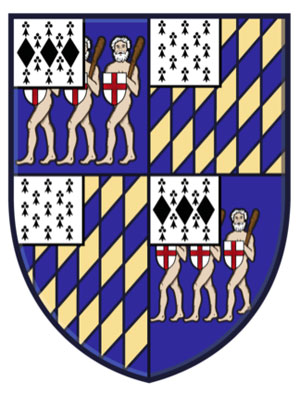 Arms of The Rt Hon. Edward Frederick Lindley Wood, 1st Earl of Halifax
Arms of The Rt Hon. Edward Frederick Lindley Wood, 1st Earl of Halifax• 16 April 1881 – 8 August 1885: Edward Frederick Lindley Wood
• 8 August 1885 – 1910: The Hon. Edward Frederick Lindley Wood
• 1910 – 25 October 1922: The Hon. Edward Frederick Lindley Wood MP
• 25 October 1922 – 22 December 1925: The Rt. Hon. Edward Frederick Lindley Wood MP[46]
• 22 December 1925 – 3 April 1926: The Rt. Hon. The 1st Baron Irwin PC[47]
• 3 April 1926 – 18 April 1931: His Excellency The Rt. Hon. The Lord Irwin PC, Viceroy and Governor-General of India[48]
• 18 April 1931 – 19 January 1934: The Rt. Hon. The Lord Irwin PC
• 19 January 1934 – December 1940: The Rt. Hon. The 3rd Viscount Halifax PC
• December 1940 – 1944: His Excellency The Rt. Hon. The 3rd Viscount Halifax PC, HM Ambassador to the United States of America
• 1944–1946: His Excellency The Rt. Hon. The 1st Earl of Halifax PC, HM Ambassador to the United States of America
• 1946–1959: The Rt. Hon. The 1st Earl of Halifax PC
Honours• Honours of Edward Wood, 1st Earl of Halifax
Marriage and familyHalifax married Lady Dorothy Evelyn Augusta Onslow (1885–1976), daughter of William Onslow, 4th Earl of Onslow, former Governor-General of New Zealand, on 21 September 1909.[4]
They had five children together:[49]
• Lady Anne Dorothy Wood, OBE JP (31 July 1910 – 25 March 1995); married Charles Duncombe, 3rd Earl of Feversham, on 14 December 1936.[50]
• Lady Mary Agnes Wood (31 July 1910 – 3 August 1910)
• Charles Ingram Courtenay Wood, 2nd Earl of Halifax (3 October 1912 – 19 March 1980)
• Major Hon Francis Hugh Peter Courtenay Wood (born 5 October 1916, killed in action[51] 26 October 1942)
• Richard Frederick Wood, Baron Holderness (5 October 1920 – 11 August 2002); MP from 1950, holding office from 1955.[12]
In popular culture• Halifax was portrayed by Richard Murdoch in the 1981 TV miniseries Winston Churchill: The Wilderness Years.
• Halifax features in the novel The Remains of the Day by Kazuo Ishiguro and the 1993 film of the same name, in which he is portrayed by Peter Eyre.
• Halifax appears in the film Gandhi, portrayed by Sir John Gielgud. The film incorrectly depicts him as possessing a left hand.
• Halifax appears as Lord Irwin in the film The Legend of Bhagat Singh, played by the Israeli actor Gil Alon.
• Halifax is a significant character in Michael Dobbs' novels Winston's War and Never Surrender.
• He is portrayed by British actor Richard Durdon in the BBC docudrama miniseries Dunkirk (2004).
• His cabinet struggle with Churchill is the subject of the 2011 play Three Days in May by Ben Brown.
• He appears as a character in the BBC television drama Cambridge Spies played by James Fox.
• He was played by Donald Sumpter in the HBO/BBC biographical film Into the Storm.
• Halifax is mentioned in the 2011 novel The Afrika Reich by Guy Saville, an alternative history novel in which Halifax became Prime Minister following a massacre of British forces at Dunkirk, the novel's divergence point, and negotiates an uneasy peace with Nazi Germany. He also plays a minor part in the 2015 sequel The Madagaskar Plan.
• In the alternative history novel Dominion by C. J. Sansom, World War II ended in June 1940 when the British government, under the leadership of Halifax, signed a peace treaty with Nazi Germany in Berlin. Due to poor health, Halifax resigned as Prime Minister in 1941 and was succeeded by the 78-year-old David Lloyd George.
• In the alternative history novel For the Sake of England by Richard K. Burns, in which Winston Churchill was born in New York City in 1874 when his mother Jennie Jerome left his father Lord Randolph Churchill and was elected President of the United States in 1936, Halifax became Prime Minister in 1940 and signed a peace treaty with Nazi Germany after the Battle of France. However, Hitler betrayed Halifax and attacked the UK in 1941, leading the United States to enter the war.
• In Upstairs Downstairs, Halifax is portrayed by British actor Ken Bones.
• Halifax appears briefly in three different alternate history novel series by Harry Turtledove: Worldwar, Southern Victory, and The War That Came Early. In Southern Victory, he is portrayed with a modicum of dignity and integrity, whereas in the other two series he is portrayed as an incompetent bumbler used for comic relief.
• Halifax is mentioned in episode four of Close to the Enemy, where it is claimed he had been given a now defunct key to the back garden of Buckingham Palace to enable him secret meetings with Queen Elizabeth to discuss matters of state, intimating that he might have been a front runner for Prime Minister ahead of Winston Churchill.
• Halifax is portrayed by Stephen Dillane in Joe Wright's 2017 drama Darkest Hour, opposite Gary Oldman as Churchill.
See also• List of covers of Time magazine (1920s) – 12 April 1926
Notes1. Matthew 2004, p. 81.
2. Roberts 1991, p. 10.
3. Roberts 1991, p9
4. Jump up to:a b c d e f g Matthew 2004, p. 82.
5. Roberts 1991, p11
6. Roberts 1991, pp11-12
7. Matthew 2004, p. 83.
8. Matthew 2004, p. 84.
9. Matthew 2004, p. 85.
10. Roberts 1991, pp. 78–79.
11. Keith Feiling, A Life of Neville Chamberlain (London: Macmillan, 1970), p. 275.
12. Matthew 2004, p. 88.
13. Lois G. Schwoerer, "Lord Halifax's Visit To Germany: November 1937." Historian 32#3 (1970): 353–375.
14. The Earl of Halifax, Fulness of Days (London: Collins, 1957), p. 185.
15. Andrew Roberts, The Holy Fox. The Life of Lord Halifax (Phoenix, 1997), p. 282.
16. Jago 2015, p. 85.
17. "Britain to increase spending on arms". The Guardian. 4 March 1935. Retrieved 31 October 2017.
18. Matthew 2004, p. 86.
19. Jago 2015, p. 106.
20. Christopher Andrew, The Defence of the Realm: The Authorized History of MI5 (London: Allen Lane, 2009), p. 208.
21. Howard 1987, p. 96.
22. Matthew 2004, p. 87.
23. "Conduct of the War". Hansard. 8 May 1940. Retrieved 2 January 2013.
24. Jenkins 2002, p. 582.
25. Roberts 1991, pp. 275–277.
26. Jenkins 2002, p. 583.
27. On the 9 May meeting, see Taylor Downing, "Cometh the finest hour." History Today 60.5 (2010): 25ff.
28. Jenkins 2002, p. 586.
29. Roberts 1991, p. 279.
30. Roberts 1991, p. 277.
31. Blake, Robert (1993). "How Churchill Became Prime MInister". In Blake, Robert B.; Louis, William Roger (eds.). Churchill. Oxford: Clarendon Press. pp. 264–270. ISBN 0-19-820626-7.
32. "Churchill decides to fight on". BBC. Retrieved 1 January 2013.
33. Halifax, p. 215.
34. Colville, Fringes of Power, p. 321.
35. Martin, Stanley (2007). The Order of Merit: one hundred years of matchless honour. London: I. B. Tauris. p. 375.
36. Roberts 1991, p. 14; the book says "there" which presumably means at Temple Newsam rather than the Leeds City Museum.
37. Matthew 2004, p. 89.
38. "Compute the Relative Value of a U.K. Pound". Archived from the original on 31 March 2016. Retrieved 29 October 2017.
39. Roberts 1991, p. 14.
40. A Gentleman with a Duster [pseud. for Harold Begbie], The Conservative Mind (London: Mills & Boon, 1924), pp. 47–48.
41. Harold Macmillan, Winds of Change (London: Macmillan, 1966), p. 531.
42. Lord Butler, The Art of the Possible (London: Hamish Hamilton, 1971), p. 77.
43. Maurice Cowling, The Impact of Hitler: British Politics and British Policy, 1933–1940 (Cambridge University Press, 1975), p. 9.
44. Matthew 2004, pp. 85–88.
45. "Making history with brick and mortar". Hindustan Times. 15 September 2011. Archived from the original on 5 December 2012.
46. "No. 32759". The London Gazette (Supplement). 24 October 1922. p. 7527.
47. "No. 33117". The London Gazette. 25 December 1925. p. 8567.
48. "No. 33139". The London Gazette. 5 March 1926. p. 1667.
49. The Peerage, entry for 1st Earl of Halifax
50. Lady Anne Dorothy Wood profile, thepeerage.com; accessed 27 March 2016.
51. Christ Church Oxford, Biography Archived 2012-12-24 at the Wayback Machine
Bibliography• Churchill, Winston S., Their Finest Hour. New York, 1949.
• Churchill, Winston S., The Gathering Storm. Boston, 1948.
• Colville, John, The Fringes of Power: 10 Downing Street Diaries 1939–1955. New York, 1985.
• Dalton, Hugh, The Fateful Years, Memoirs 1939–1945. London, 1957.
• Gilbert, Martin, Churchill: A Life. New York, 1991.
• Gilbert, Martin, Finest Hour: Winston S. Churchill 1939–1941. London, 1983.
• Gilbert, Martin (ed.), The Churchill War Papers Volume I: At the Admiralty. September 1939 – May 1940. London, 1993.
• Gilbert, Martin (ed.), The Churchill War Papers Volume II: Never Surrender. May 1940 – December 1940. London, 19.
• Gries, Thomas E. (ed.), The Second World War: Europe and the Mediterranean. West Point, New York 2002.
• Halifax, Lord, Fullness of Days. New York, 1957.
• Howard, Anthony, RAB: The Life of R. A. Butler, Jonathan Cape 1987 ISBN 978-0224018623.
• Jago, Michael, Rab Butler: The Best Prime Minister We Never Had?, Biteback Publishing 2015 ISBN 978-1849549202.
• Jenkins, Roy, Churchill. London: Pan, 2002. ISBN 0 330 48805 8.
• Liddell-Hart, B. H., History of the Second World War. Old Saybrook, CT: Konecky & Konecky, 1970. ISBN 978-1-56852-627-0.
• Lukacs, John, Five Days in London: May 1940. Yale University, 1999 ISBN 0-300-08466-8.
• Matthew (editor), Colin (2004). Dictionary of National Biography. 60. Oxford: Oxford University Press. ISBN 978-0198614111., essay on Halifax (pp. 81–89) written by David Dutton.
• Roberts, Andrew, The 'Holy Fox': The Life of Lord Halifax. London, 1991.
• Schwoerer, Lois G. "Lord Halifax's Visit To Germany: November 1937." Historian 32.3 (1970): 353-375.
• Young, Peter (ed.), Illustrated World War II Encyclopedia. Volume 2. Jaspard Polus, Monaco 1966.
References• Christopher Andrew, The Defence of the Realm: The Authorized History of MI5 (London: Allen Lane, 2009).
• A Gentleman with a Duster [pseud. for Harold Begbie], The Conservative Mind (London: Mills & Boon, 1924).
• Lord Butler, The Art of the Possible (London: Hamish Hamilton, 1971).
• Maurice Cowling, The Impact of Hitler: British Politics and British Policy, 1933–1940 (Cambridge University Press, 1975).
• Keith Feiling, A Life of Neville Chamberlain (London: Macmillan, 1970).
• The Earl of Halifax, Fulness of Days (London: Collins, 1957).
• Andrew Roberts, The Holy Fox: The Life of Lord Halifax (Phoenix, 1997 (originally published 1991)).
Further reading• Alan Campbell-Johnson and R. Hale. Viscount Halifax: A Biography. 1941
• Earl of Birkenhead. Earl of Halifax: The Life of Lord Halifax. Hamilton, 1965.
External links• Works by Charles, Lord Halifax Lindley at Faded Page (Canada)
• Works by or about Edward Wood, 1st Earl of Halifax at Internet Archive
• Hansard 1803–2005: contributions in Parliament by the Earl of Halifax
• Lord Irwin
• Biography, spartacus-educational.com
• Bibliography
• Lord Halifax, Our War Aims – Now and After, radio broadcast November 1939
• Newspaper clippings about Edward Wood, 1st Earl of Halifax in the 20th Century Press Archives of the ZBW
